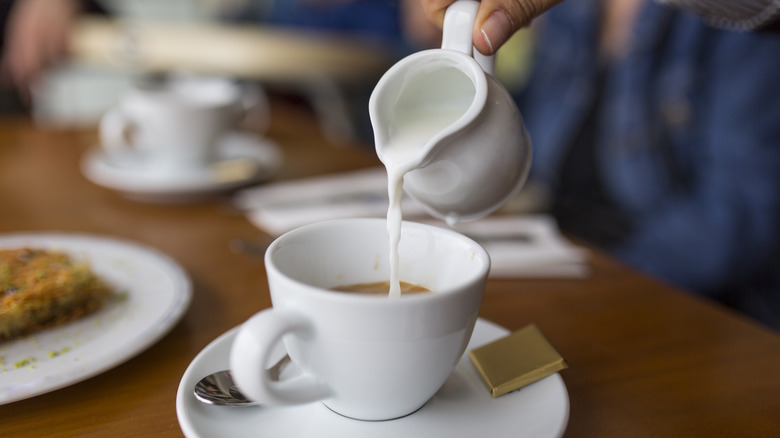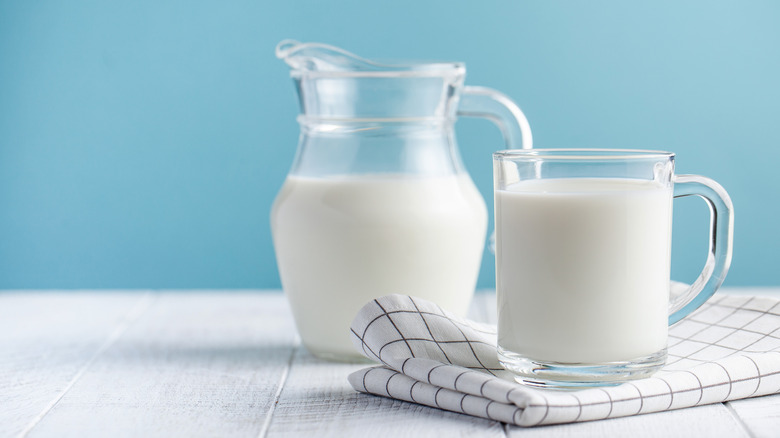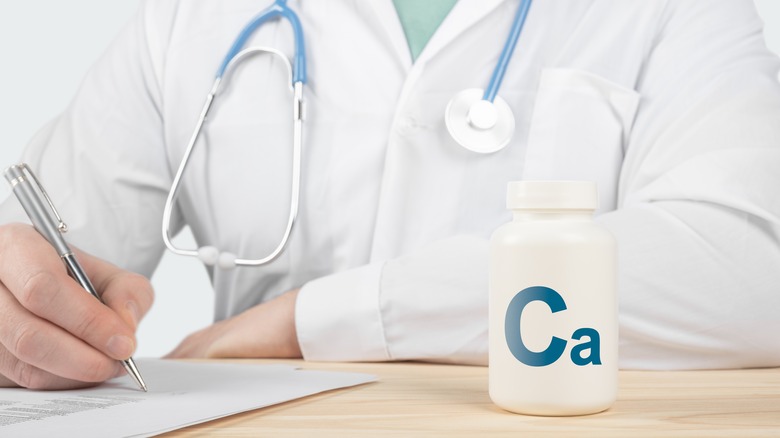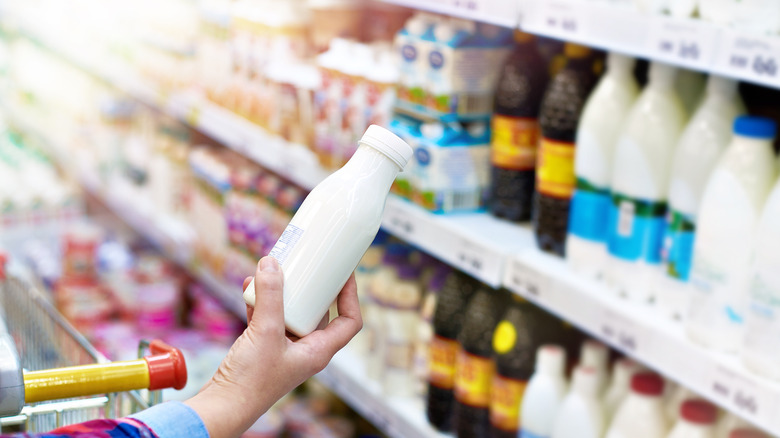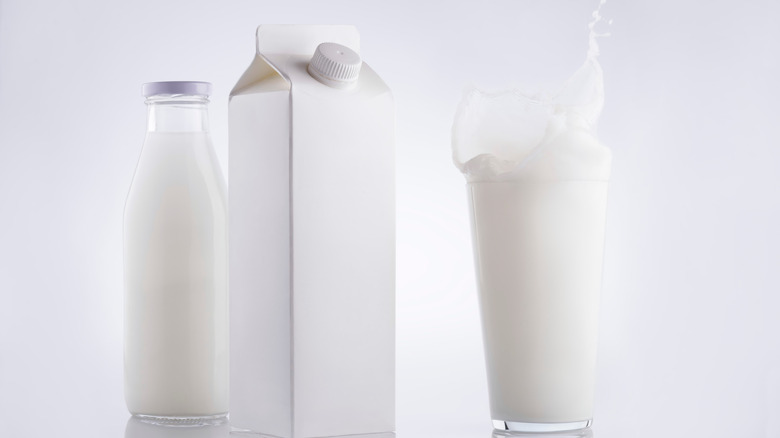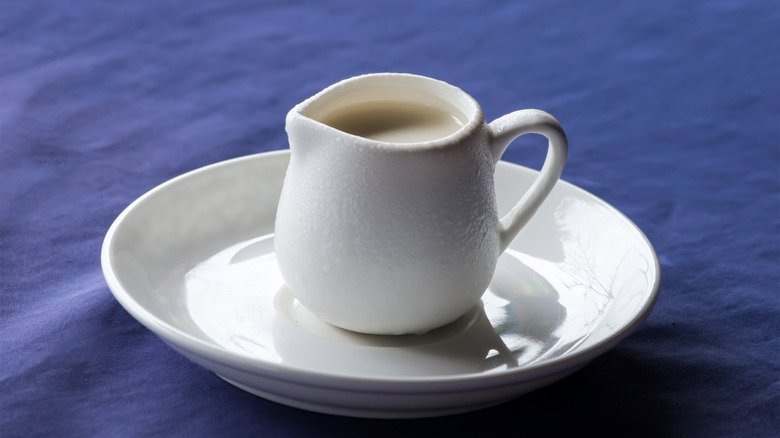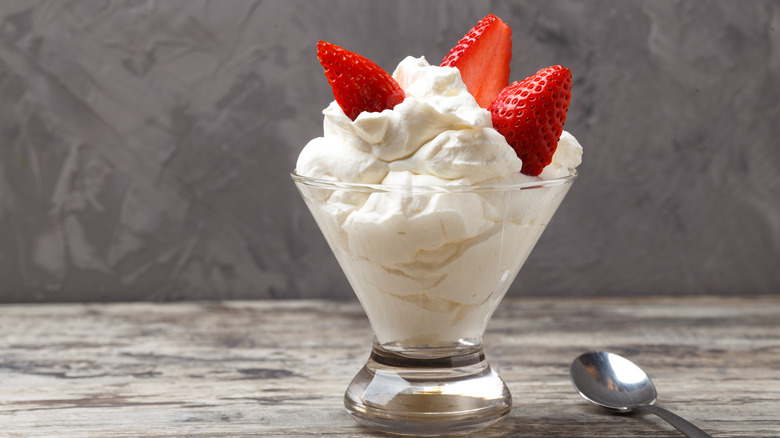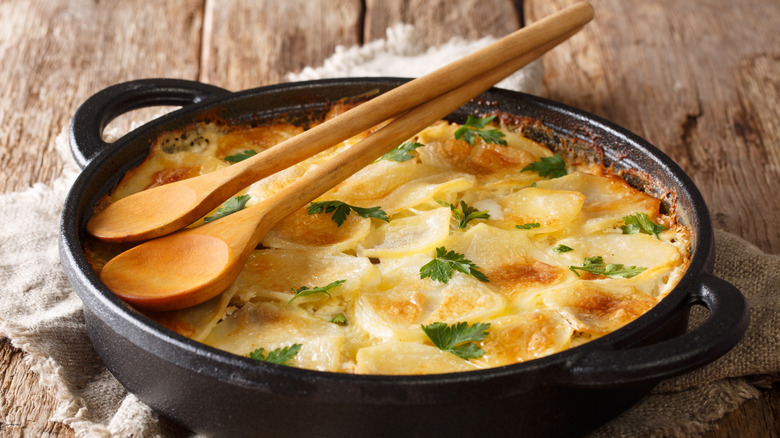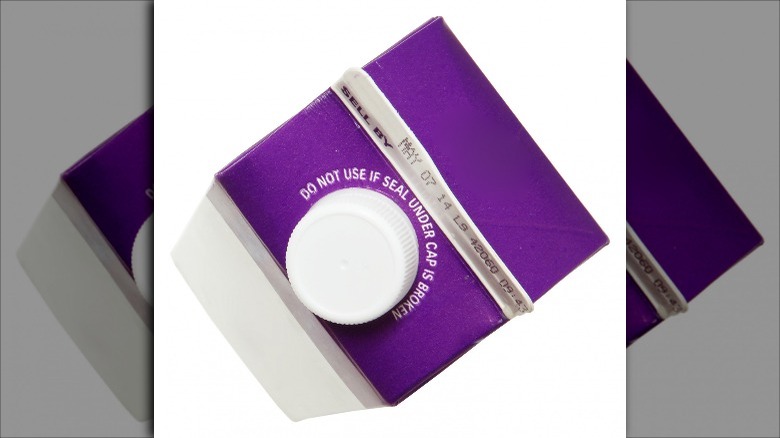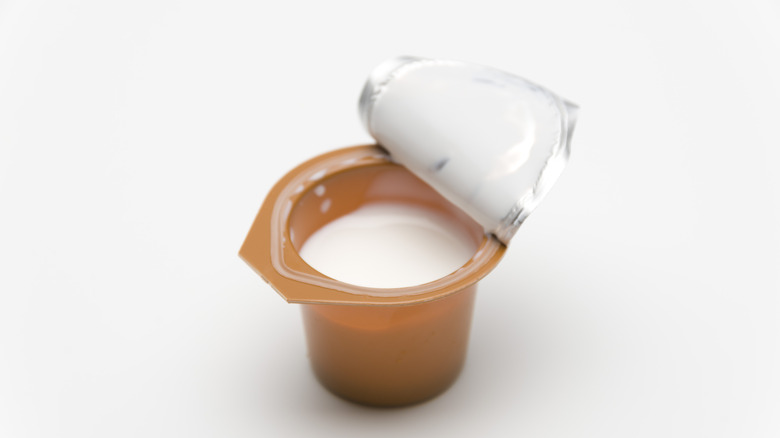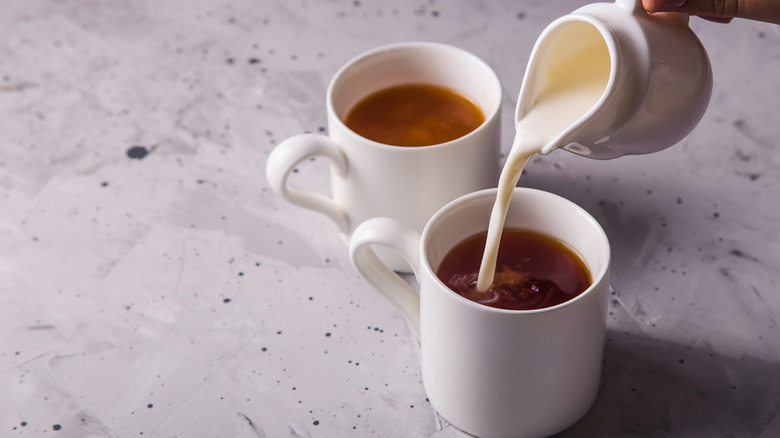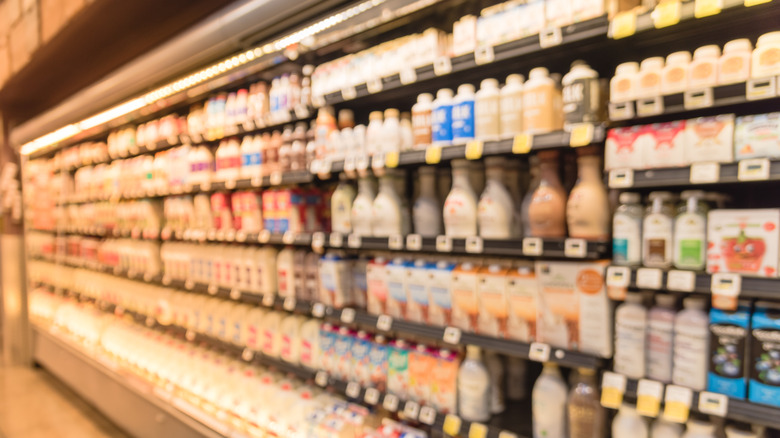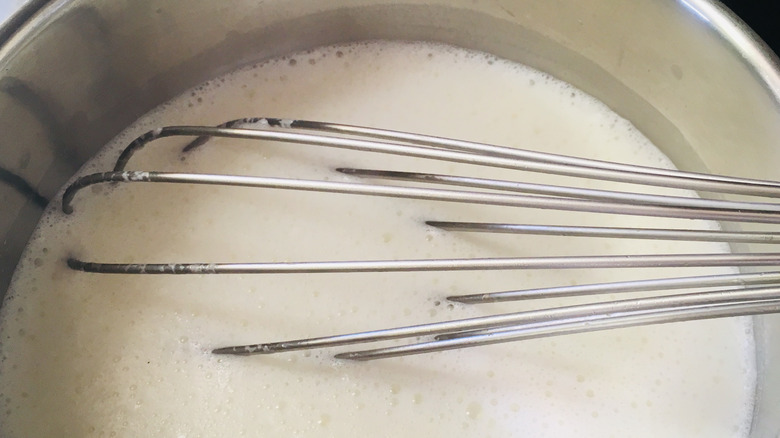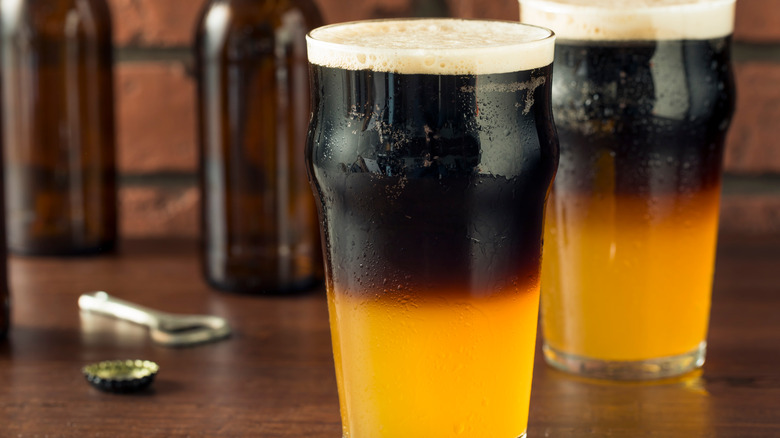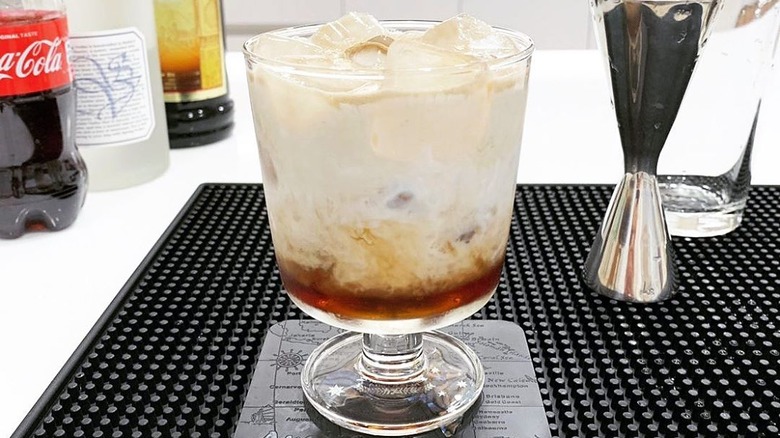Half-And-Half: What You Should Know Before You Buy
We may receive a commission on purchases made from links.
If you've ever sat down at a cozy cafe or a classically decorated diner, chances are you've added half-and-half to your coffee, whether it was served up in a metal pitcher or those individually-sized plastic containers. Or, perhaps it's been a part of your daily routine at home for years, adding a splash to your morning cup of joe.
Half-and-half has many uses in addition to making your coffee that much better, as it's featured in a number of recipes for quiches, soups, sauces, and more to make them creamier, but what exactly is the stuff? Half-and-half is one of the many options found in the refrigerated dairy section at your local grocery store, but do you know exactly what you're getting when you pick up that carton off the shelf? There's much more to it than just a great splash of dairy to add texture to your coffee. Here's what you need to know about half-and-half before you buy it.
How is half-and-half made?
Long before half-and-half became a staple in your local grocer and household refrigerator, it was first made by dairy farmer, William A. Boutwell, in 1927. According to Voltage Coffee, Boutwell invited 75 customers to Boutwell Dairy in Palm Beach, Florida (known then as Lake Worth Beach) for a taste of an experimental product that was praised for being a sweet alternative to milk, and a wonderful condiment for thickening sauces. Half-and-half remained an experiment for about 10 years before it was popularized and distributed to other stores. Over the years, Boutwell served on the Palm Beach County School Board as well as the Office of the City Commission. This allowed him to extend the reach of his business before he retired in 1956 and later sold his half-and-half business in 1965.
Today, half-and-half is an everyday ingredient that is, quite literally, made using half milk and half cream. While the U.S. Food & Drug Administration has specific parameters in which this mixture can truly be called half-and-half, that doesn't you can't make your own version when you need a quick substitute for half-and-half. Depending on what you have on hand, you can use whole-, skim-, evaporated milk, and heavy or light cream in varying measures.
What does half-and-half taste like?
When a Reddit user wondered out loud about Americans' use of half-and-half in their coffee, many responses highlighted the three attributes of this dairy product in comparison to milk or cream: rich, creamy, sweet. So while a splash of milk and a small heap of sweetener might give you a good cup of coffee, half-and-half will upgrade it to a decadent beverage.
While we advise that you shouldn't add milk to your scrambled eggs, the combination of milk and cream has been found to be potent elsewhere. Not only does it boost the taste of coffee and other hot beverages, mashed potatoes, soups, and pasta sauce, it can also enhance the velvety textures and flavors of milk- or custard based desserts including panna cotta, ice cream, flan, and crème brûlée. The Spruce Eats has taken this a step further and showcased fancy cocktails that incorporate half-and-half, including Floating on Cloud 9, Angel's Tip and, a Chocolate Margarita.
Is half-and-half healthy?
The biggest difference between the sum of half-and-half and its parts –- milk and cream –- is fat content. Half-and-half contains less fat than cream but more than whole milk, with a 100-gram serving of half-and-half containing 7 grams of saturated fats (via Livestrong). Saturated fats can have an adverse impact on health by increasing the risk of heart disease and cholesterol. However, you're still better off consuming saturated fats from full-fat dairy products rather than those found in sugary and fried foods (via Healthline). Per Livestrong, the nutrient profile of this same portion of half-and-half also includes 15% of the daily recommended value for vitamin B2, 11% for A and B5, and 8% for vitamin B12, calcium, and phosphorus.
Most people assume low-fat and fat-free dairy products are a healthier option than full-fat. However, according to Harvard Health, fat-free half-and-half is healthy "in the same way that diet soda is good for you because of what you are not having," not because it actually offers you distinct nutritional benefits. Instead, a review in the European Journal of Nutrition found that "observational evidence does not support the hypothesis that dairy fat or high-fat dairy foods contribute to obesity or cardiometabolic risk, and suggests that high-fat dairy consumption within typical dietary patterns is inversely associated with obesity risk." So ultimately, whether or not half-and-half is healthy still boils down to the type you consume as well as the overall quality of your diet.
Where do you buy half-and-half?
For in-store purchases, you can find half-and-half in the dairy aisle of most grocery outlets such as Target. You'll generally find it packaged in pints, quarts, or mini cup singles. The mini cups may not be available at your local grocery store, but they can be purchased in packs of 24, 100, and 180 from Walmart and other big-box chains. With so many people shifting toward online shopping as a necessity and/or a matter of simple convenience, you can also make an order for direct delivery to your home via online services like Instacart and Amazon.
While most people will have access to half-and-half (or at least the ingredients to make a substitute version should the need arise) through the channels mentioned above, what happens if you're craving the particular flavor and texture of half-and-half but are lactose intolerant or vegan? You can use these same channels to get the ingredients you need to make My Frugal Home's vegan half-and-half recipe using coconut cream and dairy-free milk. It will need a little bit of extra patience and care, but because of the high fat content found in coconut cream, this is a version that can be whipped! Add a cherry on top even if you're neither vegan nor lactose intolerant.
It's half milk and half cream
People have been putting a splash of half-and-half in their morning coffee or afternoon iced Americano for a long time, but what exactly is it made of? Half-and-half is simply just a mixture of milk and light cream, and according to Kitchn, it's typically made with whole milk rather than skim or 2%. But that's it. Equal parts milk, equal parts cream, equals half-and-half. The name makes a lot of sense now.
To truly call the dairy product half-and-half, according to the U.S. Food & Drug Administration, it is required to consist of no less than 10.5% milk fat, but less than 18%. From there it can be pasteurized or ultra-pasteurized, or include stabilizers or flavors, as long as the label notates its additions. There are a few varieties such as low-fat and fat-free half-and-half that use other types of milk or additives, but true half-and-half is about as simple of a dairy combo as it gets.
Half-and-half has less fat than heavy cream
Standing in front of the dairy cooler, dumbfounded, you may find there's a ridiculous number of cream options. Seriously, how are there so many? Half-and-half is different than heavy cream, which is also different than whipping cream and light cream. But what's the difference when it comes to fat content?
According to Kitchn, products with a higher fat content will be a thicker cream. Half-and-half typically contains 12% fat, while heavy cream clocks in all the way up to 38% fat. One tablespoon of half-and-half will add 1.6 grams of fat to your count for the day, with 1.1 grams of that coming from saturated fat. Alternatively, one tablespoon of heavy cream will add a whopping 5.4 grams of fat to your count, with 3.5 grams from saturated fat.
According to the USDA, adults consuming a 2,000 calorie per day diet should typically eat 44 to 77 grams of fat daily, and it's pretty easy to get to that number without even thinking. But at least opting for half-and-half instead of cream will give you a fraction of the amount of fat you're adding to your morning coffee.
You can't use half-and-half to make whipped cream
If you've ever gone to the store and decided you were feeling brave enough to make your own whipped cream instead of the aerosol can in the dairy coolers, this may have happened to you. It's not uncommon to grab half-and-half off the dairy shelf instead of whipped cream. After all, it's pretty much in the same carton.
But once you get home and try to whip it up, you'll sure realize it doesn't work. And that's all due to the difference in fat content. According to Kitchn, the thicker the cream, and those with a higher fat content, are easier to whip into stable peaks.
Because of the lower fat content in half-and-half, it will never be able to achieve those fluffy, cloud-like peaks of whipped cream you're looking for. When making whipped cream correctly, you need heavy cream with its 38% fat content. This will result in a more-versatile whipped cream that will hold its shape much longer than other options. With a difference in milk fat content of over 20% on average, there's just no way half-and-half is up to the task.
Half-and-half has to be tempered when cooking
When you throw heavy cream into a vodka sauce for your upcoming penne pasta dish, it usually will work right into the mixture without much fuss, adding a beautiful, creamy texture to the sauce. But it's just not that easy if you've decided to use half-and-half. According to Real Simple, dishes like quiche, mashed potatoes, or soups work well with the addition of half-and-half, and it can pretty well be used interchangeably with heavy cream, but it needs a little help along the way.
According to Real Simple, cream options with a higher fat content are more resistant to curdling, but if you're using half-and-half, curdling can be avoided with tempering. To temper half-and-half, you should put a small amount of the hot liquid you're trying to add it to into a bowl. Then, add the half-and-half and slowly whisk it. You should repeat these steps two times to slowly introduce the cream into the mixture before adding it back to your dish. This makes the temp gradually increase, rather than the abrupt addition that would cause curdling.
Half-and-half is designed for a long shelf life
When you grab your carton of half-and-half from the dairy cooler, along with your gallon of milk, you may notice their 'best by' dates definitely don't match up. Well, different dairy equals a differing best by date. And it's all due to the processing that occurs before dairy products hit the grocery store shelves.
The majority of half-and-half products on the market are ultra-pasteurized before hitting the shelves. According to Cornell University, when a product is ultra-pasteurized, it's heated to a minimum of 280 F, and it stays at that temp for at least two seconds. During this process, it kills any bacterial concerns, and from there it's packaged in sterile conditions so bacteria can't find its way back into the product. Cornell University reports that on average, ultra-pasteurized products can hang out on the shelves for 30-90 days with refrigeration. But once the carton is open, it becomes contaminated by open elements and only has 7-10 days left for ideal consumption.
The shelf-stable half-and-half minis have a bunch of extra ingredients
When you're sitting at your favorite diner, adding those cute mini containers of half-and-half to your coffee, you may want to consider how many extra ingredients are in them. It's definitely not your normal mixture of just milk and cream found in refrigerated half-and-half.
The shelf-stable minis do contain milk. Yet, somehow, they're able to be kept out of refrigeration, with an ideal temp of 45-80 F. And that's all due to chemical additives. Many of the individual serving sized half-and-half options on the market contain sodium citrate, datem, tetrasodium pyrophosphate, and carrageenan. According to Healthline, carrageenan is an additive meant to thicken foods and drinks, but it also acts as a preservative. Sodium citrate is used as a flavoring agent, as well as an anticoagulant. With the number of items added to make the shelf-stable minis, it makes you wonder whether you're just better off grabbing the carton from the refrigerated section.
You can get low-fat half-and-half
Because regular half-and-half is made up of the simple combination of cream and whole milk, the mixture leaves a bit of room for adjustments, particularly in the milk category. In theory, with options of 1%, 2%, and skim milk on the market, half-and-half producers could mix any option of milk fat percentages with cream. Whole milk is used as a standard to achieve that creamy consistency, but using low fat milk offers consumers a welcome option with lower fat and calorie counts.
According to food labeling standards set by the U.S. Food & Drug Administration, any product labeled low fat must contain 3 grams or less of total fat per 100 grams. Or, no more than 30% of calories coming from fat. To achieve this title, some companies like Land O Lakes will combine non-fat milk with cream to lower the fat content to less than half a gram per tablespoon. But even with the lower fat content, it can pretty much be used interchangeably with regular half-and-half.
You should never buy fat-free half-and-half
While low-fat half-and-half is a fair option if you're trying to consume less calories and fat, fat-free half-and-half definitely is not. If you actually want an option that still has milk and cream , do not ever buy fat-free half-and-half. Seriously, never. As it turns out, fat-free half-and-half has no cream in it whatsoever. According to Bon Appétit, fat-free half-and-half is actually just skim milk that went through a thickening process with the help of corn syrup and other additives. According to Time, fat-free half-and-half will typically incorporate carrageenan, artificial color, disodium phosphate, guar gum, and vitamin A palmitate. But if you're comparing a laundry list of additives to simply milk and cream, senior clinical dietitian at Texas Children's Hospital, Kristi King, told Time you might as well just have the real thing.
But if you're needing a lower calorie option other than half-and-half, Bon Appétit notes that you should just use skim milk. Whatever other option you choose, at least, you won't be dumping a bunch of additives into your morning coffee
You can make half-and-half yourself
If the day comes when you wake up, head to the fridge, and try to pour yourself a cup of coffee with half-and-half, only to find the carton empty, there's still an alternative. Since half-and-half and literally just a mixture of milk and cream, you can easily make it yourself!
If you're working on a recipe for baked goods or cooked dishes like soups or pasta sauces, making a substitute will work in a pinch if you run out as well. According to Bon Appétit, simply mix equal parts of whole milk and cream together. Put the mixture in a jar or a cup with a lid and shake it up a bit. That's it! Bon Appétit reports that it may end up separating slightly when you add it to your coffee, since it didn't go through the homogenization process, but it's barely noticeable.
According to The Spruce Eats, it's also possible to combine low-fat milk and heavy cream together for a lighter mix. Or, if you don't have any heavy cream in the house at all, you can add a tablespoon of melted butter to a cup of whole milk to achieve the same consistency and milk fat content.
Half-and-Half means different things in other countries
As it turns out, half-and-half does not mean the same thing to all people. In the U.S. and Canada, hearing half-and-half referring to a dairy product is pretty commonplace, but rumor has it, in order to receive the same product in the U.K., you'll have to ask for half cream instead (via The Spruce Eats).
But the variable names don't stop there. According to Huffpost, saying half-and-half in Ireland means you're ordering a beer made up of two brew styles combined. According to VinePair, the drink, also sometimes known as a Black and Tan, is a two-toned layered beer made up of Guinness and Bass Ale, or another type of pale ale. The ale is poured in the glass first, with Guinness topping it off.
Huffpost also says that asking for half-and-half in Brussels will get you a mixture of champagne and white wine. As for North America, our use of the world half-and-half will still get you that half milk, half cream mixture we've all come to know and love, without any alcohol.
You can put half-and-half in cocktails
If you've ever sipped on a White Russian, Spanish Coffee, or even a Key Lime Pie Martini at the bar, chances are you've had heavy cream or half-and-half in your cocktail. Heavy cream is often added to cocktails to give them a creamy texture, breaking through a bit of acidity from the alcohol. But half-and-half is a great alternative to ask for when you're not all that interested in sipping on a whole cup of cream and don't want to dilute the flavor of the alcohol. Plus, restaurants usually have it on hand more often since it's used for coffee anyway.
But you can't just pour a bunch of half-and-half in a cocktail and assume it will mix together perfectly. There's a bit of science that goes on with the process (via Art of Drink). Because of the acidity of alcohol, it doesn't always mix well with just plain milk. Milk doesn't have a high enough fat content to fend off what happens during the curdling process, which is why heavy cream is often used. But, if you introduce it correctly, with just topping off your cocktail glass, half-and-half works wonderfully and a little bit can go a long way in making a cocktail so much more delicious.
